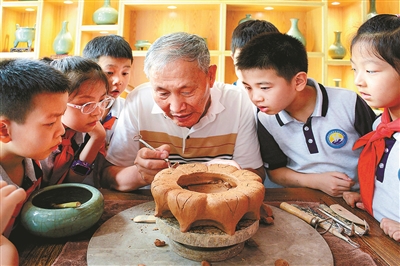imperial kiln of southern song dynasty

ye guozhen, a master porcelain-maker, works on the base of a lotus flower-shaped vessel, which is based on the design for the main stadium of the 19th asian games to be held in hangzhou, zhejiang province, in september 2022. [photo/hangzhou.com.cn]
the song dynasty (960-1279) witnessed the flourishing of chinese porcelain. the five major kilns were the guan, ge, ru, ding and jun kilns. guan kiln, or the imperial kiln, was the leading one. it baked porcelain exclusively for the imperial court. there were the imperial kiln of the northern song dynasty (960-1127) and the imperial kiln of the southern song dynasty (1127-1279).
the imperial kiln of the southern song dynasty was modeled on that of the northern song dynasty after the imperial family moved its capital south from kaifeng to hangzhou. it was built to bake porcelain for daily use in the imperial court and for sacrificial rites.
as a combination of craftsmanship and art, the porcelain baked at the kiln was elegant and of primitive simplicity, representing the changes in chinese aesthetic standards.
the porcelain was designed to have both practical and artistic values. in particular, some pieces were baked as ornaments for the imperial court so the craftsmen worked hard to produce beautiful glazes.
the products of the kiln feature thin bodies and thick glazes, producing a heavy, smooth feel, like jade, another favorite ornament of the chinese people.
cracks in the glaze, which were deliberately made as decorative patterns, are flaws that appeared on the surface of the porcelain during baking. cracks can be divided into several types, including broken-ice cracks, which will appear when the glaze is very thick and the body between two layers of glaze was very thin. "gold silk and iron thread" was another famous type, with the thick black cracks nicknamed "iron thread" and the thin yellow cracks "gold silk". together they created a patterns like two nets covering the vase.
mostly, the pieces baked at the kiln were bowls, plates, bottles and washing vessels. these superb chinese products were priceless treasures that have been handed down for centuries.
-
'nice' to meet you, hangzhou
may 6, 2024

